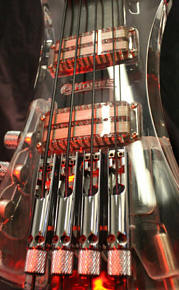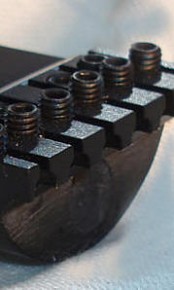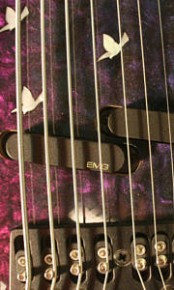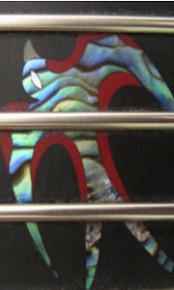BunnyBass Interview: Stephen Mosher of Moses Graphite Neck
March, 2001
A few weeks ago we had a chance to do a back-and-forth Q&A with Steve Mosher, president of Moses Graphite, via e-mail. Some of us here at BunnyBass are very interested in the use of non-traditional materials in the construction of bass guitars, and we’ve had a few jazz-type basses built using Steve’s graphite necks with great success. So an opportunity to chat with Steve Mosher a little about his perspectives on graphite necks turned out to be very informative and fun for us. I hope you find some of the information included in this interview useful to your overall bass-knowledge too! ~bunnybass
P.S. A special thanks goes out to 31Hz for helping to set up this interview. Thanks Tim!
bunnybass: How did you come to specialize in making graphite necks?
Stephen Mosher: In 1979, I was an acoustic bassist performing extended jazz around the northwest US. When I was asked to play electric bass, I picked-up my ’62 P-bass and was dissatisfied with the results. (As an aside I now consider that old bass a great instrument.)
I had previously designed and built many things out of plastic-based materials; surfboards, hydrofoil belly boards, Plexiglas facsimiles of stain glass windows, automatic live fish food feeders, etc. I became interested in using high tech boating materials, and applied them to constructing my first composite neck. The rest is history.
bunnybass: What was it, in particular, that you were dissatisfied with? and how did using plastic-based materials become part of the solution?
Stephen Mosher: At the time I felt that the wood instruments (especially bass) were lackluster in tone. Although they provided depth to the sound of the music, I wanted to have a voice that the average listener could recognize, without sacrificing depth. Most listeners, even now (but less so), do not know how to listen to the bass. They feel it, which is great, and not something to be ignored. However, they do not appreciate the instrument as melodic voice. I felt and still feel that the bass can have both depth and a texture that stands out to the average listener. I believe the bass can provide both the depth and rhythmic bottom, and have melodic impact at the same time. In other words, this is more like being the supportive bottom end while providing/adding true melody/harmony to the music. I do not believe that it has to be one or the other at a time.
I have heard great players using perfectly well constructed instruments, usually wood, but some graphite, who lose the low end and depth when they solo. This is due to the responsiveness of the instrument, and sometimes due to the pre-conceived notion of the player, that they have to get ‘thin’ and trebly to be heard. Without trying to sound prissy and ego-driven I will point out two examples: Wooten has this problem a lot in live performance mixes. Quite often all most of the average ear audience hears of his solos is the upper clank and pop. I think that Oteil B. has found his voice as a major guitar range bass soloist due to the way his basses speak to him. I have been at concerts where there were multiple bassists, and the Modulus players were all playing guitar roles while the other bassists were in the lower range. This was not arbitrary.
Regardless, my question was: Why can’t the bass do a solo that listeners will both rhythmically and melodically appreciate, using the the full potential range of the instrument?
It just so happens that the sparkle inherent in our necks works extremely well for guitar. The sustain is great, and the other technical aspects of the graphite material produce stability. However, my prime focus has always been tone generation.
bunnybass: What exactly is the material you use in your “graphite” necks?
Stephen Mosher: The definition of a graphite neck varies by who you talk to. My definition is that it is a neck that is not wood-based, while primarily using graphite or carbon fiber with epoxy resin (as the adhesive/stabilizer) for its stiffness. Phenolic fingerboards, wood blocks in the heel, adding Kevlar, fiberglass, aluminum, polyester gel coats, etc. all seem to be a part of some manufacturers ‘graphite’ necks, but I do not think that these are the essential trademarks. We do not use any of the above additives, so would be considered more purists. However, we do have models with Diamondwood, stabilized wood fingerboards, and we do use silicon-based products in our necks, along with Epoxy and graphite fiber. In what configuration, you may ask? Well, we aren’t talkin’.
bunnybass: what are the steps involved in making a moses neck?
Stephen Mosher: Although I will not disclose the particulars, I can say that we prepare our raw materials, produce a molded part from them, process the neck through a Computer Numerical Controlled Machine (CNC), do inlay and fretwork, and then do final clean-up and inspection of the product. In the development of our product(s), we have paid close attention to producing proper tension/compression ratios, and insuring stiffness with adjustability in the neck beam. We have additionally done extensive R&D, resulting in our approach to and outcome relative to tone modeling.
bunnybass: how did you arrive at your neck shapes? the jazz necks we’ve purchased from you felt noticeably slimmer and faster than most jazz basses…
Stephen Mosher: Although we started out with j-bass neck profiles; that were like the pre-CBS units, we eventually wanted to produce what we and some others consider a more modern profile style. You see these on Zon Basses and somewhat on Soundgear, amongst others. Unlike some necks, ours do not become weaker with a thinner profile, so we could get away with it. We basically split the difference between the old ‘neck getting thicker and thicker until it becomes the heel thickness’ style and the parallel fingerboard and back of shaft style. Keep in mind that Leo set some interesting electric bass parameters without advanced information and based upon perceived ease of production. This is reflected in the neck profile, that they basically just wanted to run an elliptical cutter along the back of the neck shaft and exit at the shaft to heel transition. It was easier to run this cutter in a straight line and pull out. This leaves more meat in the neck, which they needed for stiffness. Thus players came to expect the shape. As an aside, 34″ was just an arbitrary guess that stuck. Fender could have just as easily made them any old scale, like 35″. Then (Geoff) Gould would have had to innovate the 36″ scale, heh.
bunnybass: When you were developing the “recipe” for your graphite necks, what kind of sound were you going after? what kind of variables did you have to play with in the search for that sound?
Stephen Mosher: Due to my background in music, and like many others, I have been drawn to the sound of fine wood instruments. However, many instruments that sound pretty good solo, get lost when part of an ensemble. For instance, if you listen to a beautiful Gibson L-5 guitar, the tone is really great in a quiet solo setting. However, the sound gets quite unclear in the mix of a group performance. And if your life depended on correctly pinpointing the tonal center of such a note played under ensemble conditions, you might well not live to enjoy the next song. So, I decided to produce a beam that would produce notes containing a strong fundamental and a complete harmonic overtone series, while cleaning up some of the superfluous ‘fuzzy’ transients that make a note indistinct. I determined that these fuzzy transients cancel out some of the more fundamental aspects of a note, altering the overall development of the struck note, and resulting in less sustain. Given a note that has ‘fullness’ in the initial attack, sustain allows for development of its harmonic content. I believe that this results in development of a sound with character. I essentially wanted a warm tone with sparkle. I believe that we have achieved that.
The variables we look at include stiffness in tension/compression, and the effects of relative placement of materials to effect density within various parts of the neck beam. We produce neck beam structures from scratch for both technical and sonic reasons. This is very different than choosing an already produced material, and honing a shape out of it.
bunnybass: So in summary, how would you describe the fundamental characteristics of your bass and guitar necks?
Stephen Mosher: A strong fundamental, a complete, balanced harmonic overtone series, increased swell and sustain, full rich tone.
bunnybass: Relatively speaking, how much of an instrument’s sound is owed to the structural and material composition of the neck, versus that of the body?
Stephen Mosher: Both have a significant impact, and they are dependent upon one another. You can take a great neck and put it on a terrible body, with delirious results, and vise versa as well. With neck through body coupling you have much better control of the continuity of the sound and dead/hot spots. In a de-coupled bolt-on situation, you can only do so much, depending on the body (and the bridge). I’ll go one step further and say that you can put together a great neck and body, and if the hardware does not match up, it may suck. We have taken a particular good neck-body unit with a complete set of parts and simply swapped bridges around. The results were everywhere from great to disgustingly poor. Builders/manufacturers mostly just choose their idea of a good set of parts, assemble them and present them to the players based upon relatively incomplete information. I don’t believe that anyone in the world has taken all the potential necks and bodies, mated them with all possible electronics/hardware/string combinations and compiled an objective catalogue rating the best to worst combos. It is unrealistic. So builders just do what they think is best at the time. And, even if one were to construct what in their own eyes was the absolute ultimate match of elements at a moment, someone is going to make a part that is different, all combinations would have to be tested with this new part to see if it improved it, on and on. And after all that, it really comes down to the proficiency of the player. A great player can make a mediocre instrument sound darn good; a bad player can’t make a great instrument sound worth beans. As Rick Turner has said, “You want ten tone controls, look at your fingers.”
bunnybass: Given the consistency you’re able to achieve from neck to neck (as opposed to people who construct necks from wood), perhaps you’re in a good position to comment on how much difference fingerboard materials have on the sound a neck produces…
Stephen Mosher: We do not use unstabilized wood fingerboards due to instability factors. No reason to set-up stresses in a stable neck by gluing a fingerboard on that wants to move. Then the neck beam has to work against it to maintain. So, I am truly not well versed in wood fingerboard effects. Our Diamondwood boards are stable and even in density. They produce a clear woody warmth, that is bell-like, especially in the upper register. The Graphite boards are warm, but a little fuzzier sounding with somewhat of a more natural compression.
bunnybass: What are the most common misconceptions people have about instruments with graphite necks?
Stephen Mosher: By far the most common misconception is that all graphite necks are the same. In fact, graphite is simply a fibrous material that can be used in an immensely wide range of embodiments.
Another is that a graphite neck is made out of this one stuff called graphite. As described above, different graphite neck manufacturers use graphite fiber with an epoxy base, combined with a broad range of support materials inside as well as for fingerboard and neck shaft surfaces.
Yet another misconception is that if you want to have an instrument with old ‘vintage’ materials, wood is the only stuff. My humorous perspective may twist a brain cell or two, but petroleum-based (fossil fuel) products are a heck of a lot older than any tree harvested on the earth’s surface by man. They include fossilized fauna and flora (trees), along with other truly old organic and mineral materials from the bowels of the ancient earth. Additionally, carbon/graphite is considered by the scientific community as the basic element of all life forms. So, what could be more down to the bone than a graphite neck, eh?
bunnybass: What do you think of the idea of people trying to create a neck, using new materials technologies, that is identical in sound and feel to a traditional wood neck (flat sawn maple or something…)? useful endeavor? stupid? theoretically impossible?
Stephen Mosher: I believe that all areas of exploration are fair game. I completely support the efforts of both traditionalists and cutting edge innovators. I think that coming up with new solutions to better solve old problems, and to re-discover old solutions that are redeemed as superior for resolving both old and new situations, are both great. To leave convention behind, developing entirely new, previously unimagined ideas with their unique problems and inventive solutions, is vastly intriguing yet not realistic for most of us. This is because it is so utterly common that ‘new’ ideas truly emerge from the existing cosmic pool of ideas already in our stream of consciousness.
Regarding copying tone: I think that it is possible to get close enough that most people will not recognize the difference.
bunnybass: “New” design innovations are often introduced as a response to some very old problems. on the other hand, new designs sometimes encourage the investigation of new directions in traditional artistic forms too. where do you think the use of new materials in electric amplified instruments are leading us? where do you situate yourself in relation to this question of “technology-driving-art”?
Stephen Mosher: The technology of the day always contributes to art, whether it is the quality of the paints and brush hairs available to a painter, the carpentry tools available to a woodworker, the quality of the charcoal or lead to a sketch artist, etc.
Any inventor, innovator, etc. is just in the middle of an endless process of exploration. I don’t really know when it all began, and I doubt that it will ever end as long as life exists. The only reason that man continues to re-visit the same old problems is from lack of vision to see things fresh and in new ways, being willing to let go of pre-conceptions and baggage of the past. At the same time, it is certainly valuable to refine human ergonomics. Fender-style guitars and basses are certainly not the ultimate in ergonomically friendly instruments. However, I kind of like them in a nostalgic way. Anyway, I believe that innovation will continue to expand the horizons of musical instrument aud nausium, with variable outcome. It’s great. Can’t seem to find a better way to spend my time.
bunnybass: I’ve heard a lot of people say that bass players are generally more receptive to instrument-design innovations than guitarists. do you think this is a fair statement? (why?)
Stephen Mosher: I believe that this has been true in recent years because the role of bassists has changed to incorporate more melodic flourishes and solo input in modern music. Bassists needed to re-define their sound to make it audible to the average listener’s ear. Rather than solely being a rhythmic thump, an extension of the bass drum, they now at times come to the forefront. Since guitarists, for instance, were already there, they didn’t require such a boast. There is only so much that one can do to change a guitar and have it still be a guitar, and not for instance, a synthesizer trigger. But there seems to be a lot more range of possibility for bassists. This will probably level out in the not to distant future.
bunnybass: What are some of the things we can look forward to, insofar as where moses is headed in the near future?
Stephen Mosher: We have been increasing our OEM manufacturing substantially. You will see a great increase in the use of our products on other finished instruments. Gibson Steinbergers, Chapman Sticks, and Soloette Travel Basses are three, with lots coming. We will introduce our own of solid and framed body headstocked and headless 5-string basses late this year. And we are work some exciting big surprises that really won’t mature for about 6-7 years.










